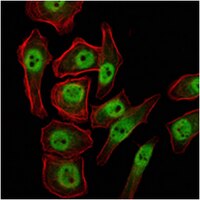MABN685 Sigma-AldrichAnti-KDM4A Antibody, clone5H1
Anti-KDM4A Antibody, clone5H1 is a highly specific mouse monoclonal antibody, that targets Jumonji domain-containing protein (JMJD) & has been tested in western blotting, IHC & Immunofluorescence.
More>> Anti-KDM4A Antibody, clone5H1 is a highly specific mouse monoclonal antibody, that targets Jumonji domain-containing protein (JMJD) & has been tested in western blotting, IHC & Immunofluorescence. Less<<Recommended Products
Overview
| Replacement Information |
|---|
Key Spec Table
| Species Reactivity | Key Applications | Host | Format | Antibody Type |
|---|---|---|---|---|
| H | WB, IHC, IF | M | Ascites | Monoclonal Antibody |
| References |
|---|
| Product Information | |
|---|---|
| Format | Ascites |
| Control |
|
| Presentation | Mouse monoclonal IgG1 ascitic fluid containing up to 0.1% sodium azide. |
| Quality Level | MQ100 |
| Physicochemical Information |
|---|
| Dimensions |
|---|
| Materials Information |
|---|
| Toxicological Information |
|---|
| Safety Information according to GHS |
|---|
| Safety Information |
|---|
| Packaging Information | |
|---|---|
| Material Size | 100 µL |
| Transport Information |
|---|
| Supplemental Information |
|---|
| Specifications |
|---|
| Global Trade Item Number | |
|---|---|
| Catalogue Number | GTIN |
| MABN685 | 04053252917509 |
Documentation
Anti-KDM4A Antibody, clone5H1 SDS
| Title |
|---|
Anti-KDM4A Antibody, clone5H1 Certificates of Analysis
| Title | Lot Number |
|---|---|
| Anti-KDM4A, clone5H1 - VP1401034 | VP1401034 |
| Anti-KDM4A, clone5H1 - QVP1305164 | QVP1305164 |
| Anti-KDM4A, clone5H1 - VP1911083 | VP1911083 |
| Anti-KDM4A, clone5H1 -VP1510020 | VP1510020 |
| Anti-KDM4A, clone5H1 -VP1606280 | VP1606280 |
| Anti-KDM4A, clone5H1 Monoclonal Antibody | VP1709151 |










ethyl] acetate[821014_[(Butoxyethoxy)ethyl] acetate-ALL].jpg)





